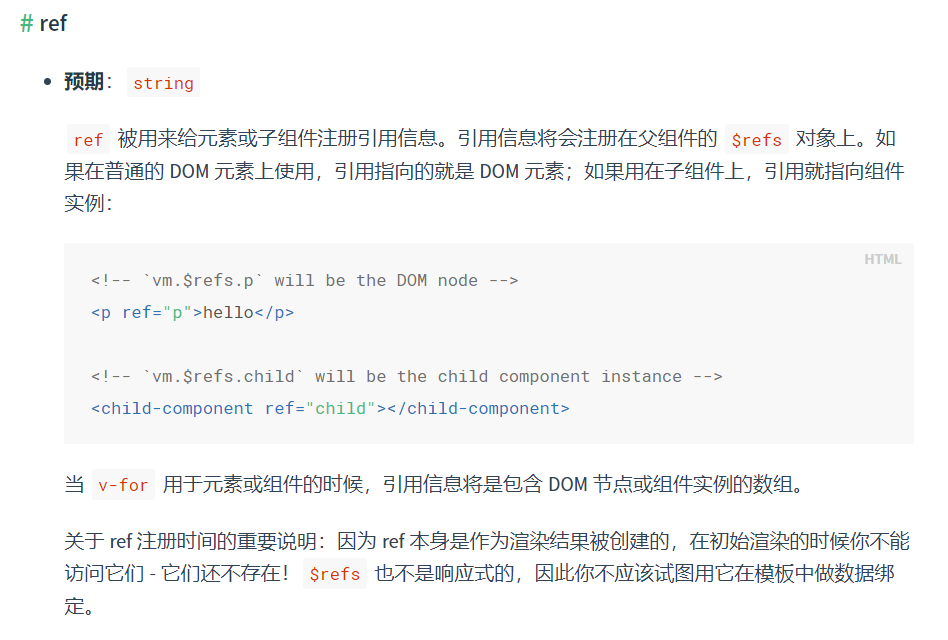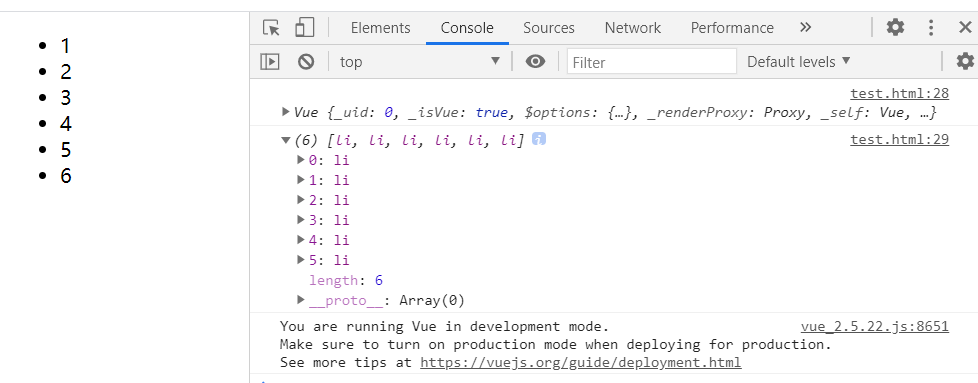ref 有三种用法:
1、ref 加在普通的元素上,用this.ref.name 获取到的是dom元素
2、ref 加在子组件上,用this.ref.name 获取到的是组件实例,可以使用组件的所有方法。
3、利用 v-for 和 ref 得到的 ref 将会是一个包含了对应数据源的这些子组件的数组

注意:
1、ref 需要在dom渲染完成后才会有,在使用的时候确保dom已经渲染完成。比如在生命周期 mounted(){} 钩子中调用,或者在 this.$nextTick(()=>{}) 中调用。
2、如果ref 是循环出来的,有多个重名,那么ref的值会是一个数组 ,此时要拿到单个的ref 只需要循环就可以了。
ref在普通的元素上
<div id="ref-outside-dom" v-on:click="consoleRef" >
<component-father>
</component-father>
<p ref="outsideDomRef">ref在外面的元素上</p>
</div>
<script>
var refoutsidedomTem={
template:"<div class='childComp'><h5>我是子组件</h5></div>"
};
var refoutsidedom=new Vue({
el:"#ref-outside-dom",
components:{
"component-father":refoutsidedomTem
},
methods:{
consoleRef:function () {
console.log(this); // #ref-outside-dom vue实例
console.log(this.$refs.outsideDomRef); // <p>标签dom元素 ref在外面的元素上</p>
}
}
});
</script>ref在组件上
<div id="ref-outside-component" v-on:click="consoleRef">
<component-father ref="outsideComponentRef">
</component-father>
<p>ref在外面的组件上</p>
</div>
<script>
var refoutsidecomponentTem={
template:"<div class='childComp'><h5>我是子组件</h5></div>"
};
var refoutsidecomponent=new Vue({
el:"#ref-outside-component",
components:{
"component-father":refoutsidecomponentTem
},
methods:{
consoleRef:function () {
console.log(this); // #ref-outside-component vue实例
console.log(this.$refs.outsideComponentRef); // div.childComp vue实例,组件实例
}
}
});
</script>ref循环获取dom数组
<div id="app">
<ul>
<li v-for="item in list" ref="items" >{{item}}</li>
</ul>
</div>
<script>
var vm = new Vue({
el: "#app",
data: {
list: [1, 2, 3, 4, 5, 6]
},
methods: {
},
created: function () {
this.$nextTick(() => {
console.log(this)
console.log(this.$refs.items)
})
}
});
</script>
- 本文链接:http://horry233.github.io/2020/10/20/vue%E4%B8%AD%E7%9A%84ref%E5%92%8C/
- 版权声明:本博客所有文章除特别声明外,均默认采用 许可协议。
若没有本文 Issue,您可以使用 Comment 模版新建。
GitHub Issues